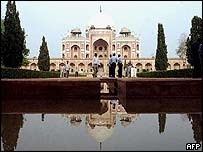 The idea was to restore it to the original shape and vision by using traditional
craftsmanship - Project architect Ratish Nand
The idea was to restore it to the original shape and vision by using traditional
craftsmanship - Project architect Ratish Nand
 http://news.bbc.co.uk/1/hi/world/south_asia/2952593.stm
http://news.bbc.co.uk/1/hi/world/south_asia/2952593.stm
Two hundred people worked for three years to revitalise the garden's pathways, fountains and water channels in the heart of the capital.
The four-part paradise garden is said to be the first example of an imperial tomb garden in the sub-continent.
Humayun's tomb contains more than 100 Moghul graves and is one of 23 World Heritage sites listed by the United Nation's cultural body, Unesco.
The gardens were formally unveiled by Islamic spiritual leader the Aga Khan at a special function on Tuesday.
Prince Aga Karim Khan, the spiritual leader of Shia Ismaili Muslims, was joined by a galaxy of eminent Indians, including Tourism Minister Jagmohan.
 The idea was to restore it to the original shape and vision by using traditional
craftsmanship - Project architect Ratish Nand
The idea was to restore it to the original shape and vision by using traditional
craftsmanship - Project architect Ratish Nand
The Aga Khan Trust for Culture donated the $650,000 spent on the project, which was carried out by the Archaeological Survey of India (ASI).
This is the first privately funded project undertaken by the ASI - the agency responsible for maintaining India's more than 3,000 monuments.
The agency has been trying to attract more private partners to help meet maintenance costs.
Water channels
Following the work at Humayun's Tomb, water is now flowing through tanks which have lain dry since the 17th century.
Humayun's Tomb Construction began in 1565
Built by Mughal Emperor Akbar in memory of his father
Made of red sandstone and white marble
Dome is 47m high (154 ft)
"The idea was to restore it to the original shape and vision by using traditional craftsmanship that existed at the time of its creation," project architect Ratish Nanda told journalists.
"So instead of cement, fruit pulp and molasses have been used to restore the edges of the tanks."
The massive tomb made of red sandstone and white marble stands on a 120-square-metre (1,290 square-foot) platform, its dome reaching a height of 47 metres (154 feet).
Mughal ruler Humayun's son, Akbar, ordered the tomb to be built in 1565 in memory of his father.
Officials say the site attracts nearly 1,000 visitors every day.
For the nearly 15 million residents of Delhi, where open space and greenery is fast becoming become a luxury for most, the lush green garden is good news.
"It is just overwhelming. I think it will restore some pride in Delhiites," historian Mushirul Hasan was quoted as saying in The Hindu newspaper.
Story from BBC NEWS:
http://news.bbc.co.uk/go/pr/fr/-/1/hi/world/south_asia/2952593.stm
Published: 2003/04/16 11:34:34
(c) BBC MMIII